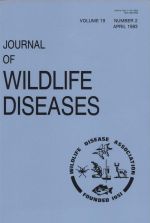Two outbreaks of botulism in central Saskatchewan in which mortality of waterfowl continued into late autumn and then recurred in the same marshes the following spring are described. Small numbers of birds were involved in each instance. Dabbling ducks (predominantly mallards, Anas platyrhynchos and pintails, Anas acuta) and American coots, Fulica americana were affected most commonly in autumn; whereas only diving ducks (predominantly lesser scaup, Aythya affinis) were found to be involved in spring. Live maggots present in carcasses despite sub-freezing temperatures were the probable source of intoxication in the autumn; the source of toxin in the spring was not determined.
How to translate text using browser tools
1 April 1983
AVIAN BOTULISM DURING LATE AUTUMN AND EARLY SPRING IN SASKATCHEWAN
G. Wobeser,
D. J. Rainnie,
T. B. Smith-Windsor,
G. Bogdan





